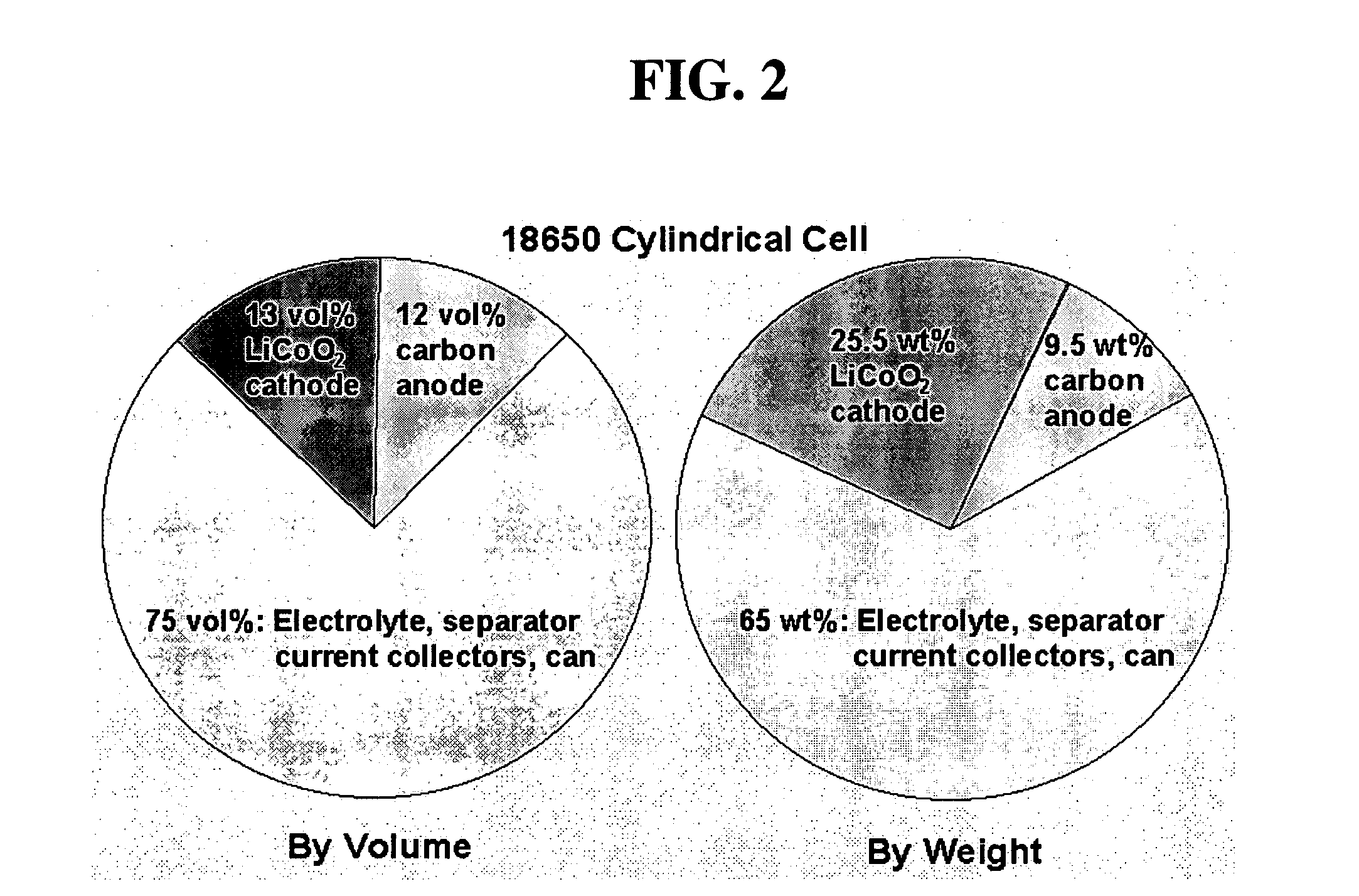High energy and power density electrochemical cells
a technology of electrochemical cells and high energy density, applied in the field of electrochemical cells, can solve the problems of high cost, toxicity, carbon-based anodes have the disadvantage of a relatively low volumetric energy density, and their derivatives suffer from disadvantages, etc., to achieve good electrochemical performance, increase electronic conductivity, and high power density
- Summary
- Abstract
- Description
- Claims
- Application Information
AI Technical Summary
Benefits of technology
Problems solved by technology
Method used
Image
Examples
example 1
Metal-Doped Compositions
[0057] This example demonstrates the preparation of compositions having the formulation Li(Fe1−aM″a)PO4, where M″ is Al, Ti, Zr, Nb, Ta, W, and Mg. Specific compositions, heat treatments, and results are listed in Tables 1 and 2, respectively. It was found that the electronic conductivity increased only for certain low concentrations of the metal additive or dopant. The specific range of concentration providing a high electronic conductivity (greater than about 10−5 S / cm) varied for each dopant but was generally less than about 5 mole % of the Fe concentration. In addition to having a low concentration of the dopant, it was necessary to heat treat the material under conditions such that high electronic conductivity was obtained. These conditions included heat treatment in a non-oxidizing gas atmosphere, including but not limited to argon, nitrogen, and nitrogen-hydrogen. Moreover, the temperature of heat treatment was less than about 800° C. At 600° C., the...
example 2
Lithium Deficient and Substituted Compositions
[0069] In this example, doped LiFePO4 was formulated to create Li deficiency and an excess of the other metals relative to the ideal cation stoichiometry of LiFePO4. The composition has the formulation (Li1−aM″a)FePO4. In this example M″ was Mg at 0.01% (a 1% Mg-doped sample). The (Li0.99Mg0.01)FePO4 sample was prepared as substantially described in Example 1, except that the doping was achieved using magnesium ethoxide, Mg(OC2H5)2, and the sample was given a second heat treatment (after the initial heat treatment of 350° C. for 10 hours in argon) at 600° C. for twenty-four hours in argon, and at 700° C. for sixteen hours in argon. These samples were compared to a sample of composition Li(Fe0.99Mg0.01)PO4, which was heat treated at 600° C. for twenty-four hours in argon.
[0070] The resistance of sintered pellets of each of the three samples was measured using a 2-probe method, wherein the contacts were spaced at an equal distance of ab...
example 3
Storage Battery Using High Rate Capability Cathode and Thin Film Anode.
[0073] A cathode storage compound of composition (Li0.99Zr0.01)FePO4, fired at 600° C. in Ar according to the methods of Example 1, and having a specific surface area of 41.8 m2 / g, was formulated into an electrode by mixing 79 wt % of the active material, 10 wt % of SUPER P™ carbon, and 11 wt % Kynar 2801 binder in γ-butyrolactone as solvent. After casting onto an aluminum foil and drying, the coating was immersed in a plasticizing solvent of 15 wt % propylene carbonate in methanol, then pressed and dried. The resulting positive electrode (cathode) was tested against a lithium metal foil counterelectrode (anode; ca. 1 mm thick) in a Swagelok cell assembly using CELGARD® 2500 separator film and 1:1 EC:DEC with 1M LiPF6 liquid electrolyte.
[0074]FIG. 5 shows discharge curves for this cell measured by the constant-current constant-voltage (CCCV) method whereby the cell was first charged at 0.5 C rate (75 mA / g), th...
PUM
| Property | Measurement | Unit |
|---|---|---|
| thickness | aaaaa | aaaaa |
| specific surface area | aaaaa | aaaaa |
| specific surface area | aaaaa | aaaaa |
Abstract
Description
Claims
Application Information
 Login to View More
Login to View More - R&D
- Intellectual Property
- Life Sciences
- Materials
- Tech Scout
- Unparalleled Data Quality
- Higher Quality Content
- 60% Fewer Hallucinations
Browse by: Latest US Patents, China's latest patents, Technical Efficacy Thesaurus, Application Domain, Technology Topic, Popular Technical Reports.
© 2025 PatSnap. All rights reserved.Legal|Privacy policy|Modern Slavery Act Transparency Statement|Sitemap|About US| Contact US: help@patsnap.com



